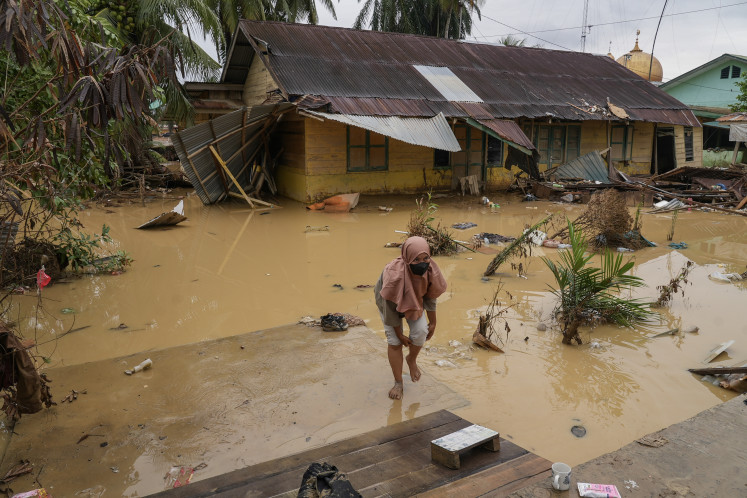Popular Reads
Top Results
Can't find what you're looking for?
View all search resultsPopular Reads
Top Results
Can't find what you're looking for?
View all search resultsStruggling to end TB amid COVID-19 pandemic
Meanwhile, Indonesia is listed as one of the world's largest TB contributors with about 842,000 cases. The COVID-19 pandemic makes it harder to eliminate TB –which remains the world's deadliest infectious disease.
Change text size
Gift Premium Articles
to Anyone
E
very March 24, the World Health Organization (WHO) commemorates World Tuberculosis (TB) Day, raising awareness about the devastating health, social and economic consequences of TB in gearing up to end the global TB epidemic. This year, however, the fight against TB looks to be sidelines by the new coronavirus pandemic.
The virus has infected more than 780,000 people throughout the world since it was first reported as an unknown pneumonia-like disease in the Chinese city of Wuhan. After the first two cases of COVID-19 in Indonesia were reported on March 2, the case number increased rapidly, climbing up to nearly 1,500 in just three weeks.
Meanwhile, Indonesia is listed as one of the world's largest TB contributors with about 842,000 cases. The COVID-19 pandemic makes it harder to eliminate TB –which remains the world's deadliest infectious disease.
TB is a disease caused by an anaerobic bacillary form, Mycobacterium tuberculosis (Mtb). Upon inhaling Mtb, 5 to 10 percent of infected people generate active tuberculosis, while the majority would develop a latent state of infection for years. In its latency period, although being dormant, the quiescent Mtb would reactivate and trigger active diseases as the immune system becomes fragile due to conditions including malnutrition, smoking, diabetes mellitus and HIV/AIDS.
Unlike the Mtb, coronavirus seeks out suitable receptors in the lungs’ parenchyma and starts to replicate. Nevertheless, both diseases affecting the lungs lead to pneumonia.
What will happen in the event of a person experiencing coinfection of Mtb and coronavirus? There are no clear answers so far. The alveolar macrophage or “dust cell” is the most important cell for protection against TB. Medical professionals have noticed a period of elevated susceptibility to bacterial infections following influenza virus infection. Several months after an influenza virus infection, the alveolar macrophages, which should clear air spaces of infectious, toxic or allergic particles, become insensitive to bacterial invasion. Similarly, we can assume that people who develop a latent TB infection while infected with a coronavirus could develop active TB.
The WHO has launched a joint initiative titled “Find. Treat. All. #EndTB” in collaboration with the movements called Stop TB Partnership and Global Fund. The aim of this cooperation is to scale up the “End TB” response toward universal access to TB prevention and care, and to call on all countries and partners, including civil society, affected communities and development financing partners, to follow the WHO’s drive toward universal health coverage.
In Indonesia, the WHO initiative is transformed to TOSS TBC (Find TB, treat until recovery). The approach aims to trace individuals with TB symptoms, treat infected patients and evaluate these measures until the affected persons are cured. Seeking people with symptoms of TB infection is a crucial step. Chronic cough, night sweat, loss of appetite, weight loss and mild fever are considered symptoms of TB.
Reliable diagnosis and comprehensive treatment are the second steps. The government has delivered free TB drugs in private and state hospitals and even community health centers (puskesmas) in suburban areas. The final measure is monitoring the treatment to make sure the patient takes the medication correctly.
The continuity of TB programs depends on the efforts of all sectors. Commitments are needed to endorse concrete and measurable specific targets, to increase resources, including human and financial resources, to expand investment in TB research and to elevate the profile of national TB programs.
Furthermore, harmonized and accountable action is fundamental to scale up the number of people tested for TB with early diagnosis of tuberculosis (drug susceptibility testing, systematic screening of contacts and high-risk groups, active case finding in vulnerable population groups), to ensure all people with TB are reported to the national authorities through a real-time notification system, and to innovate for TB diagnostic and treatment services.
Specifically, cooperation between the government and the private sector promotes prevention and the distribution of the required drugs. Then, excellent rapport between doctors and patients and their families guarantees the effectiveness of treatment.
Today, the desperate need to trace COVID-19 cases amid the ravaging spread of the virus can follow the WHO recommendation for TB in the detection, treatment and/or isolation of infected persons. At the beginning of the epidemic, the new coronavirus was believed to be transmitted through droplets from humans while sneezing or coughing. Recently, the WHO also suspects it is an airborne infection in certain conditions, such as in aerosol-generating procedures in a medical facility. Therefore, the tools to fight TB become relevant for COVID-19: natural ventilation design for infection control and contact tracing.
As for people with TB, psychosocial support is also needed to avoid and combat the stigma of people known or suspected to be COVID-19 positive. Though people are now flocking to hospitals to seek confirmation on whether they are infected, others may feel they would be stigmatized and would avoid medical consultation, thus potentially further spreading the virus in their surroundings.
Strengthening the WHO recommendations on treating and eradicating tuberculosis in Indonesia’s national TB program is also urgent to prevent even worse cases of coinfection of TB and the novel coronavirus.
Student of Graduate School of Medicine, Kobe University, lecturer at School of Medicine, Airlangga University (Unair), Surabaya










